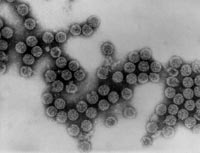![]() Environment: Bird in a Bubble?
Environment: Bird in a Bubble?
 Polyomavirus |
 suspected PDD virus |
 Pollen |
If we think about how parrots live in the wild, we can get a good opening picture of what kind of environment they evolved to thrive in.
If we keep that picture in mind when we take them into our lives and homes, then we will realize they do not need to live in a bubble. Clean well circulated air, good full spectrum light, good nutrition and an environment that is not overloaded with pathogenic (the bad boys) organisms will suit them well!
 Mold |
How far we have to go and how big a gun we need to use to keep those pathogens down to benign levels will depend a lot on what kind of environment we are talking about. In an avian clinic, sterility is required of surgical instruments and strong disinfectants are used to maintain control of potential *bad* bugs. In the average bird keeping household this would be overkill. Keeping things regularly clean of debris, washing with soapy water and occasionally disinfecting to deal with any lurking bio-film should do just fine. If the risks go up, like having a bird get sick or adding new birds to the home, then we may need to increase our bio-armament.
|
|
Of interest to the breeder or anyone dealing with young birds is a process that occurs when baby birds are developing their immune systems called *Cloacal Drinking*.
When the bird is young, an organ called the Bursa of Fabricius plays a big role in educating it's immune system regarding the antibody production that will help protect the bird through its lifetime. This organ is located in the cloaca. Normally, the cloaca is pretty much a one way road out of the bird's body, waste and eggs out and the only thing that should be going in would be sperm and the odd human introduced cotton swab. But during this window of immune development in baby birds, the movement of the cloaca (peristalsis) can reverse (retroperistalsis) to allow the bursa to sample from the outside for more diversity in antibody production. The bursa takes a *sip* of the outside world to better prepare the body for it.
 StrepA |
It's an incredibly cool process that takes the usual germs in our world and uses them to expand the bird's immune system for good health. But, if the baby is sitting on a *hot* pathogen such one of the avian viruses, the result can be overwhelming. That drink could mean the last sip, or a life of immune problems.
HEALTH |
BASIC CARE | ILLNESS AND INJURY | SYSTEMS
| FEATHER PROJECT | TAMBOPATA | VAL | LINKS
AVIAN VET | CHECK-UP | DROPPINGS | DIAGNOSTICS | EMERGENCIES | COMMON
INJURIES | CPR | WEST NILE VIRUS | IMMUNE | REPRODUCTION
DIET | ENVIRONMENT
© kgsmith 2011
No content may be used or reproduced without the author's written permission
DO NO HARM

